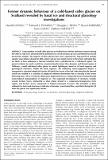Files in this item
Former dynamic behaviour of a cold-based valley glacier on Svalbard revealed by basal ice and structural glaciology investigations
Item metadata
| dc.contributor.author | Lovell, H. | |
| dc.contributor.author | Fleming, E.J. | |
| dc.contributor.author | Benn, D.I. | |
| dc.contributor.author | Hubbard, B. | |
| dc.contributor.author | Lukas, S. | |
| dc.contributor.author | Naegeli, K. | |
| dc.date.accessioned | 2015-11-01T00:11:42Z | |
| dc.date.available | 2015-11-01T00:11:42Z | |
| dc.date.issued | 2015-05 | |
| dc.identifier | 209403672 | |
| dc.identifier | 4de31780-5439-4c88-9d39-f0a15bf8c420 | |
| dc.identifier | 84937881421 | |
| dc.identifier | 000355778000011 | |
| dc.identifier.citation | Lovell , H , Fleming , E J , Benn , D I , Hubbard , B , Lukas , S & Naegeli , K 2015 , ' Former dynamic behaviour of a cold-based valley glacier on Svalbard revealed by basal ice and structural glaciology investigations ' , Journal of Glaciology , vol. 61 , no. 226 , pp. 309-328 . https://doi.org/10.3189/2015JoG14J120 | en |
| dc.identifier.issn | 0022-1430 | |
| dc.identifier.other | ORCID: /0000-0002-3604-0886/work/64697376 | |
| dc.identifier.uri | https://hdl.handle.net/10023/7724 | |
| dc.description | H.L. was funded by a UK Natural Environment Research Council (NERC) PhD studentship (NE/I528050/1), the Queen Mary Postgraduate Research Fund, and an Arctic Field Grant from the Research Council of Norway. E.J.F. was funded by a NERC PhD studentship as part of the GAINS (Glacial Activity in Neoproterozoic Svalbard) grant (NE/H004963/1). K.N. was funded by an Arctic Field Grant, the Swiss Society for Speleology, and the travel grant commission of the Swiss Academy of Science. | en |
| dc.description.abstract | Large numbers of small valley glaciers on Svalbard were thicker and more extensive during the Little Ice Age (LIA), demonstrated by prominent ice-cored moraines up to several kilometres beyond present-day margins. The majority of these glaciers have since experienced a long period of strongly negative mass balance during the 20th century and are now largely frozen to their beds, indicating they are likely to have undergone a thermal transition from a polythermal to a cold-based regime. We present evidence for such a switch by reconstructing the former flow dynamics and thermal regime of Tellbreen, a small cold-based valley glacier in central Spitsbergen, based on its basal sequence and glaciological structures. Within the basal sequence, the underlying matrix-supported diamict is interpreted as saturated subglacial traction till which has frozen at the bed, indicating that the thermal switch has resulted in a cessation of subglacial sediment deformation due to freezing of the former deforming layer. This is overlain by debris-poor dispersed facies ice, interpreted to have formed through strain-induced metamorphism of englacial ice. The sequential development of structures includes arcuate fracture traces, interpreted as shear planes formed in a compressive/transpressive stress regime; and fracture traces, interpreted as healed extensional crevasses. The formation of these sediment/ice facies and structures is indicative of dynamic, warm-based flow, most likely during the LIA when the glacier was significantly thicker. | |
| dc.format.extent | 20 | |
| dc.format.extent | 8923918 | |
| dc.language.iso | eng | |
| dc.relation.ispartof | Journal of Glaciology | en |
| dc.subject | Arctic glaciology | en |
| dc.subject | Basal ice | en |
| dc.subject | Ice dynamics | en |
| dc.subject | Structural glaciology | en |
| dc.subject | Subglacial sediments | en |
| dc.subject | GB Physical geography | en |
| dc.subject | NDAS | en |
| dc.subject.lcc | GB | en |
| dc.title | Former dynamic behaviour of a cold-based valley glacier on Svalbard revealed by basal ice and structural glaciology investigations | en |
| dc.type | Journal article | en |
| dc.contributor.institution | University of St Andrews. Geography & Sustainable Development | en |
| dc.contributor.institution | University of St Andrews. Bell-Edwards Geographic Data Institute | en |
| dc.identifier.doi | https://doi.org/10.3189/2015JoG14J120 | |
| dc.description.status | Peer reviewed | en |
| dc.date.embargoedUntil | 2015-11-01 |
This item appears in the following Collection(s)
Items in the St Andrews Research Repository are protected by copyright, with all rights reserved, unless otherwise indicated.

